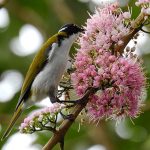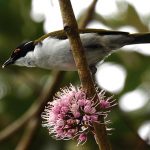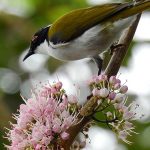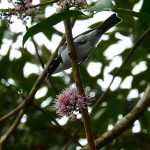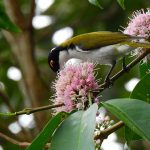WHITE-NAPED HONEYEATER
The White-naped honeyeater is a small but striking bird. It measures around 13 to 16 centimetres in length. Its most distinctive feature is the bright white patch on the nape of its neck, which contrasts beautifully with its otherwise black head. The body is primarily olive-green, and it boasts a vibrant red eye-ring that stands out against its plumage. The underparts are a softer, pale grey, making it a charming sight for birdwatchers.
This honeyeater is commonly found across a broad range of eastern and southern Australia. It inhabits eucalypt forests and woodlands, often preferring areas with a dense canopy. These birds are also found in gardens and urban parks, making them a familiar presence in many regions.
The White-naped honeyeater is known for its melodious calls. It produces a series of high-pitched, tinkling notes that can be quite musical. These calls are often heard during the breeding season and are used to communicate with mates and signal territorial boundaries.
As a honeyeater, this bird primarily feeds on nectar, which it gathers from a variety of flowering plants, particularly eucalypts. However, it is not solely reliant on nectar. It also consumes insects and spiders, which provide essential proteins, especially during the breeding season when energy demands are high. They are often seen in small flocks, especially outside the breeding season. They are social creatures and may join mixed-species feeding groups.
Breeding usually occurs from July to January, aligning with the Australian spring and summer. The white-naped honeyeater constructs a delicate, cup-shaped nest made from bark strips, grasses, and spider webs. The nest is typically placed high in the fork of a tree branch, providing safety from ground predators. The female usually lays two to three eggs, which are incubated for about 14 days. Both parents share the responsibility of feeding the chicks, which fledge approximately two weeks after hatching.
The nest of the White-naped honeyeater is a marvel of avian architecture. It is intricately woven and suspended in the branches, often camouflaged by leaves. The use of spider webs not only helps in binding the nest materials but also adds flexibility and strength to the structure.
In the wild, these birds can live up to about 8 to 10 years, although the exact lifespan can vary based on environmental conditions and predation pressures.
Currently, the White-naped honeyeater is classified as Least Concern by the International Union for Conservation of Nature (IUCN). This status indicates that the species is relatively stable, although habitat loss and changes in land use can still pose threats.
The White-naped honeyeater is a delightful example of Australia’s rich avian diversity, and its presence is a reminder of the delicate balance within our natural world. Through understanding and appreciating such species, we can be inspired to protect their habitats and ensure their songs continue to grace our landscapes.

